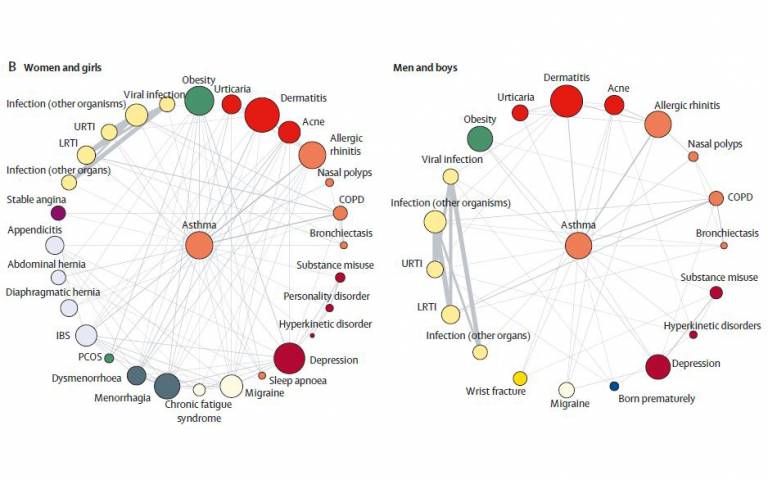Mapping the hidden connections between diseases
1 December 2022
A new study led by UCL researchers has identified patterns in how common health conditions occur together in the same individuals, using data from four million patients in England.

With advancing age, millions of people live with multiple conditions -- sometimes referred to as multimorbidity -- and the proportion of people affected in this way is expected to rise over the next decades. However, medical education and training, healthcare delivery, clinical guidelines and research have evolved to focus on one disease at a time.
The Academy of Medical Sciences and the UK Chief Medical Officer (CMO) have recognised this problem and set out a challenge of investigating which diseases co-occur in the same individuals and why.
In the new study, published in Lancet Digital Health, the team used routine health records data to systematically identify patterns of clustering of 308 common mental and physical health conditions of men and women of different ages and with different ethnicities.
Some patterns found include: heart failure often co-occurred with hypertension, atrial fibrillation, osteoarthritis, stable angina, myocardial infarction, chronic kidney disease, type 2 diabetes, and chronic obstructive pulmonary disease.
Hypertension was most strongly associated with kidney disorders in those aged 20–29 years, but with dyslipidaemia, obesity, and type 2 diabetes in individuals aged 40 years and older.
Breast cancer was associated with different comorbidities in individuals from different ethnicities, asthma with different comorbidities between the sexes, and bipolar disorder with different comorbidities in younger ages compared with older ages.
The findings, the researchers say, provide the data and resources to help improve health and care planning for patients in England living with more than one condition.
Co-author Professor Aroon Hingorani (UCL Institute of Cardiovascular Science) said: “Information from minority ethnic groups and younger people has often been missing from studies of multimorbidity, but by using diverse electronic health records, we present a more inclusive and representative perspective of multimorbidity. This is one area where the NHS electronic health records and data science can generate important insights.”
Professor Spiros Denaxas (UCL Institute of Health Informatics) said: “Millions of people live with multiple diseases, yet our understanding of how and when these transpire is limited. This research project is the first step towards understanding how these diseases co-occur and identifying how to best treat them.”
The study includes accessible tools to help users visualise patterns of disease co-occurrence, including for diseases that cluster more commonly than expected by chance, providing an entry point to investigate common risk factors and treatments.
The findings should help patients better understand their illness, doctors better plan management of patients with multimorbidity, healthcare providers optimise service delivery, policy makers plan resource allocation, and researchers to develop new or use existing medicines to treat several diseases together.
The data analysed were from the Clinical Practice Research Datalink under licence and managed securely via the UCL Data Safe Haven. All algorithms for defining the diseases are open source (and can be found here).
The research was enabled by UK Research and Innovation’s Strategic Priority Fund, NIHR UCLH Biomedical Research Centre, Health Data Research (HDR) UK, Medical Research Council, the Department of Health and Social Care, Wellcome Trust, the British Heart Foundation, and The Alan Turing Institute, in collaboration with the Engineering and Physical Sciences Research Council.
Links
- Full paper in Lancet Digital Health
- Professor Aroon Hingorani’s academic profile
- Professor Spiros Denaxas’s academic profile
- UCL Institute of Cardiovascular Science
- UCL Population Health Sciences
- NIHR UCLH Biomedical Research Centre
Image
- Comparison of comorbidities for asthma, by sex. The size of a node (circle) is proportional to the prevalence of the condition in the study period (April 1, 2010, to March 31, 2015). The width of the lines between two nodes represents how highly correlated the two conditions are. Credit: Valerie Kuan, Spiros Denaxas et al / Lancet Digital Health
Media contact
Mark Greaves
T: +44 (0)7990 675947
E: m.greaves [at] ucl.ac.uk
 Close
Close

